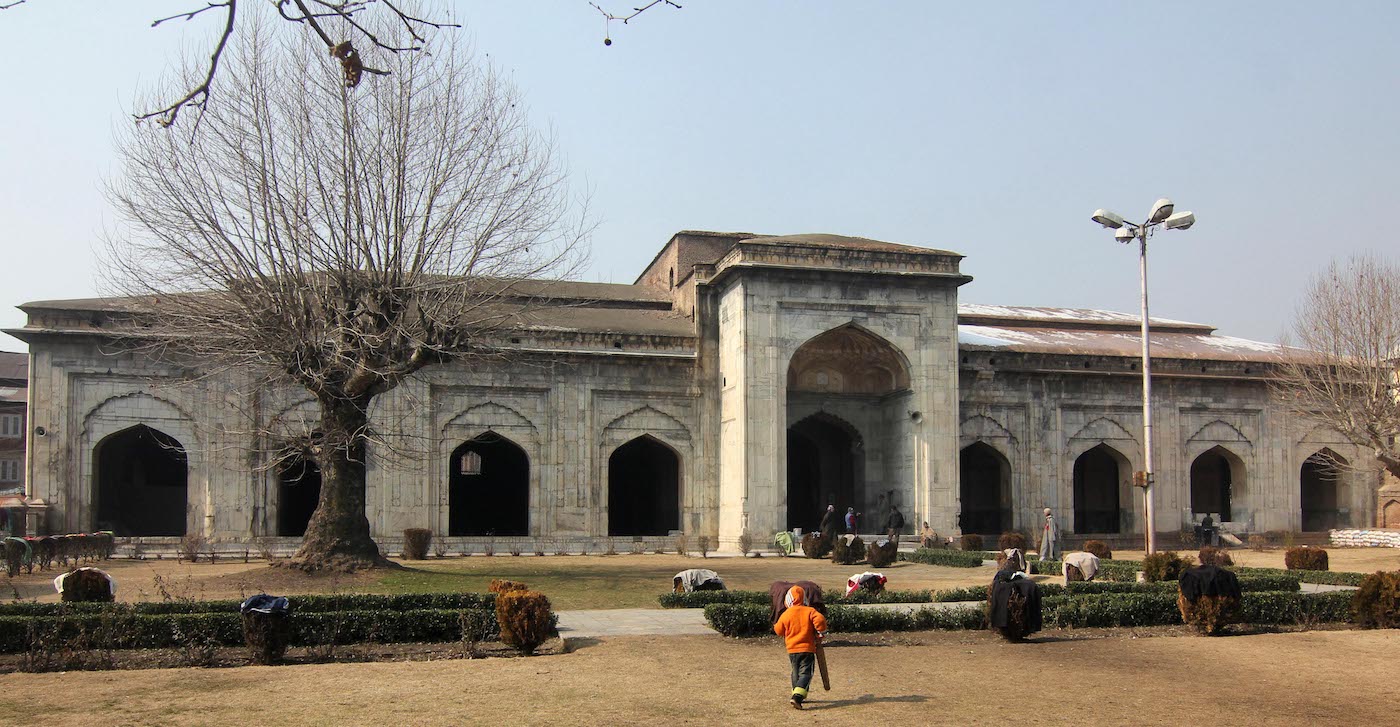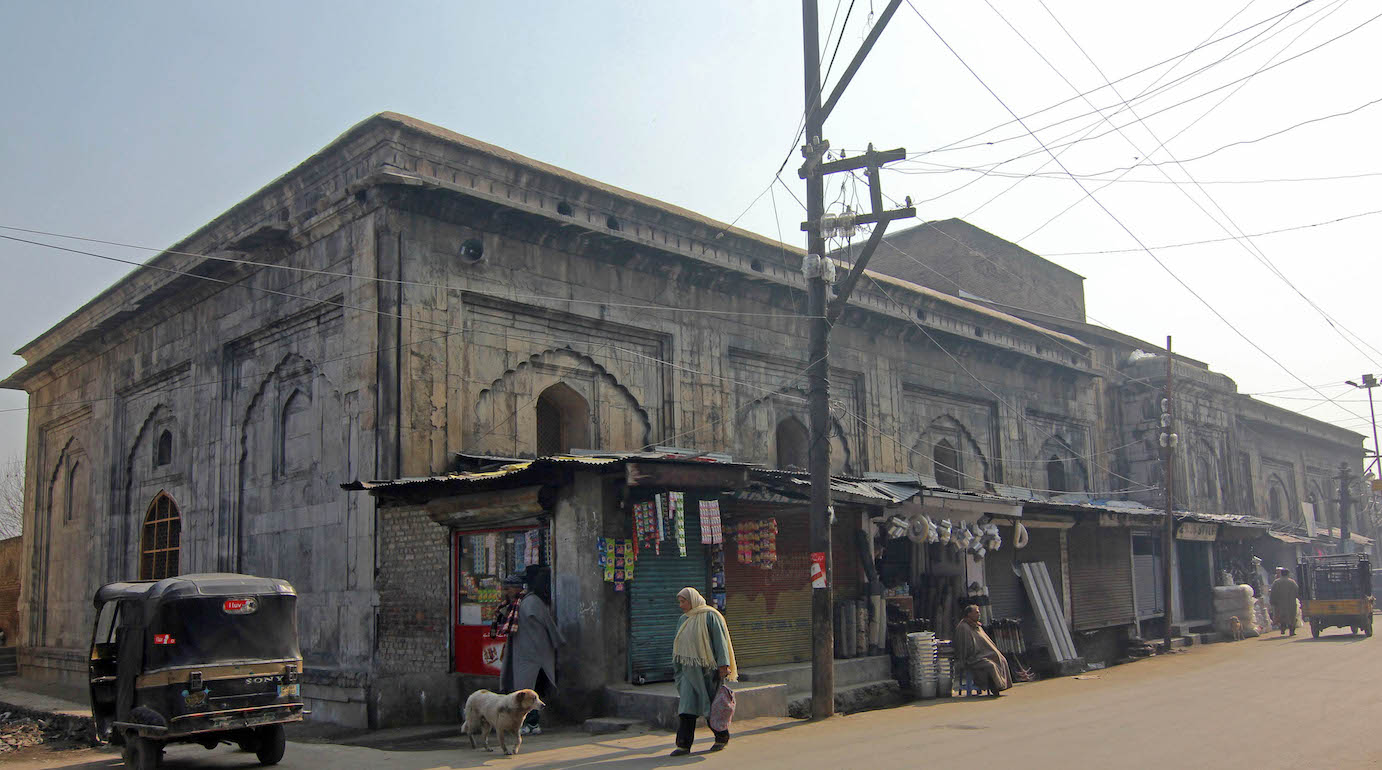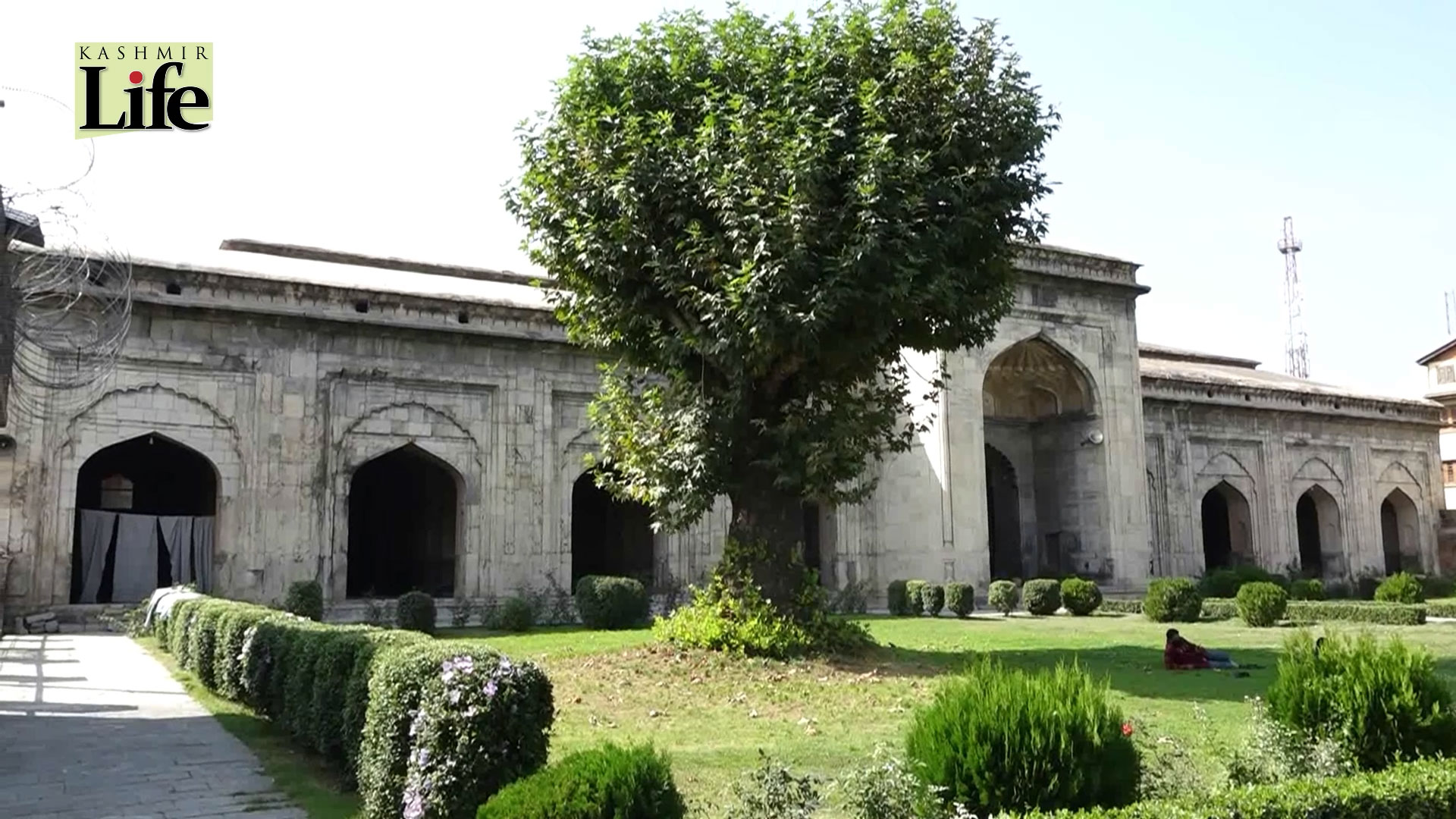A mosque constructed by the most celebrated Mughal Queen, Nur Jahan, in the heart of Srinagar fought a lot of negative narratives to survive as unique piece of Mughal architecture and a praying space for the faithful, reports Khalid Bashir Gura

Pathar Masjid (The Stone Mosque) is one of Srinagar’s key infrastructures of faith and culture. Built by Nur Jahan, the queen wife of Mughal emperor Jahangir, in 1623 AD, the mosque is also known as Naev Masjid (New Mosque) and Shahi-i- Masjid (Royal Mosque) as well This is perhaps the only mosque other than Jamia Masjid that is mentioned in history, repeatedly.
The mosque may escape ones attention as it is fenced and shaded from public view by a shop line, security checkpoints and spools of barbed wire. As one step into the lawns of the mosque, through a labyrinth of alleys, the towering silence engulfs, and the crimson leaves from the Chinars fall silently on its four rectangular gardens, Char Bagh. The garden at Pathar Masjid is divided into four rectangular quarters with a Chinar tree in each. The mosque has raised pathways decorated with flowerbeds on each side of the path.
The Cost Crisis
“There is a folktale that being once questioned regarding the cost of its construction, the Empress pointed to her jewelled slippers and replied, “as much as that”. After this the mullahs, unanimously decreed that by this sacrilegious allusion the mosque had become desecrated and was unfit for religious use,” Zareef Ahmad Zareef, Kashmir most known raconteur said.

Another fable, Zareef added, is that “the mosque was built for Shia sect surrounding the neighbourhood by the empress who herself was a Shia Muslim.” Neither of these fables has any historic reference, however.
The Mughal era mosque has witnessed many regimes ascending and descending in Kashmir but during Sikh rule (1820–1846), the mosque was closed and converted into a granary.
“The Sikhs uprooted the floor stones of the mosque and used these to construct their own religious places,” said Zareef.
1947 Revival
The mosque continued to face official apathy over the centuries, until in 1947, when Sheikh Abdullah became the Prime Minister of Jammu and Kashmir that people from adjacent places like Mujahid Manzil started to offer prayers. Over the centuries the mosque’s walls and the roof had defaced. “In the seventies, following the return of Sheikh Abdullah to power, the mosque was handed over to archaeological department and became a protected monument,” Zareef said. “The construction of shops outside the historical monument shadowed it from public view. Later, when the shops caught fire, the masjid’s stones were also damaged”.
There has been a lot of criticism against permitting the shops to come up against the mosques façade. “The people in power lacked aesthetic sense,” Zareef lamented.
In Bad State
On September 25, residents living around the Masjid protested demanding its renovation. On November 5, a mid-night blaze due to a short circuit caused partial damage to the masjid. The pulpit was fully damaged. Exposed to vagaries of weather for centuries, the historical monument, according to locals, is crumbling for lack of care and renovation.
Concerned citizenry insists that any damage to this piece of architecture can be a huge loss because there is nothing like it in Kashmir. The architecture and construction material of the masjid makes it stand apart as it is unlike other indigenous mosques and architectural marvels in Kashmir.

“Mosques, generally in the valley were built with wood while this mosque was built exclusively with locally available grey limestone and the style is practically the same as edifices found in Delhi, Agra and Lahore,” said Hakim Sameer Hamdani, an architect at INTACH, Jammu and Kashmir, adding that they have no historical references in any of the Mughal histories regarding this monument but that in itself is not surprising as many prominent Mughal monuments are not recorded. “The mosque is polished grey limestone and is the largest surviving example of fine Mughal architecture in Kashmir”.
Hamdani said that Jehangir while writing about Kashmir in his autobiography Tuzuk-e-Jahangiri has mentioned that his wife, Nur Jahan ordered the construction of a mosque in Srinagar. “But the exact date of its construction is contestable,” he said.
Mughal Style
The mosque boasts of a typical Mughal style architecture. It has Iwan – a rectangular hall or space, usually vaulted, and walled on three sides, with one end entirely open. The mosque is rectangular in plan having nine bays and sloping roof which is supported on outer walls. The columns inside are made of local grey stone. Flight of steps on either side of the central front arch provides access to inter-floor and roof.

According to Hamdani, the façade of the mosque has nine arches (Mehraabs), the middle one being the largest arched entrance. The visible coping stones of the now almost underground plinth, he said, have a series of large lotus leaves carved, and so have the portion of the walls between the projecting cornice and the eaves.
The sloping roof has twenty-seven domes ribbed internally, some flat, some barrel-vaulted and supported on eighteen massive square columns, the lower part of which is built of stone and the upper part in brick masonry, projecting sideways in cusped arches. The walls are in brick masonry with limestone. The floors are covered with stone. The ceiling is domed, ribbed, covered with lime plaster.
“The compound wall is of brick masonry having shallow arched niches,” Hamdani said.
The Summer Mosque
In comparison to the other Mughal architectures in India, it is not as grand but it is unique in Kashmir. “Owing to its non-Kashmiri architecture, the mosque is a unique space for offering of Salah (obligatory Muslim prayers) only during summer months. In winters, especially due to its location on a riverbank, the stones and its architecture render it impossible to step into due to cold,” said Prof Aijaz Ahmad Banday who earlier taught archaeology at Kashmir University. “It is the reflection of Mughal architecture without any local influence as most of the mosques and shrines in Kashmir are made of timber and bricks to suit local climatic conditions”.
But, according to Banday, in summers, offering prayers at the mosque is “a bliss”.
Presently, in its lawns, the madrassa operates in a dilapidated building and the people offer prayers at the Darasgah in winters.
While the mosque is in use, the folklore has not tied. This is despite the historians and architects refuting the accusing against the empress, who for most of her life was the ruling Queen of India, ruling in the name of her husband.
“It is not a fact,” said Hamdani, as the folklore does not find any historical record and it amounts to an allegation against Empress Nur Jahan. “It is not verified anywhere as to which Maulana questioned her regarding the construction”.
Echoing Hamdani’s views, the Convener (INTACH), Saleem Beigh also debunked the myth. He said that Nur Jahan constructed Pathar Masjid besides gardens in Kashmir.
“It is not a fact but accusation and it is recorded nowhere in history,” said Beigh who was the former Director General of Tourism in Jammu and Kashmir. He added that the mosque became politically significant after 1931 when the Kashmir was witnessing political upheaval against the Dogra regime and Sheikh Abdullah used to visit the mosque to offer prayers with a large number of people accompanying him from Mujahid Manzil.
“As religious places have played a significant role in political awareness and mass gathering, the presence of Abdullah at Pathar Masjid unnerved many of his ideological rivals who started spreading canards that the mosque has been constructed by a woman,” Beigh said. “They also played cards of sectarianism that it was built by Shia empress for Shia sect”. Denouncing the myth that prayers are not allowed at a mosque constructed by women, Prof Banday said: “It was a myopic vision of people and contradictory to Islamic jurisprudence.”
Not Just A Queen
Nur Jahan, after all, was not an ordinary individual in Jehangir’s harem, she was a co-sovereign whose name would appear on the coins and who would issue the farmans with her own seal. Modern historians see the queen as the longest ever female ruler of India, before Indira Gandhi. She ruled India for 15 years.
The royal couple were hugely attached to Kashmir. They would routinely shift their office from Agra to Srinagar for 13 years, where Shalimar would remain to be the Royal Court. In Srinagar, initially, the Emperor laid out the Shalimar garden for his queen that was extended subsequently. Later, the queen would herself appoint her brother, Asaf Khan, to set up the Nishat garden of Srinagar.
Jehangir was in love with Kashmir. History records suggest that he has married two Kashmiri origin women – daughter of Syed Mubarak Khan of Kashmir in 1593 and daughter of Hussain Chak. In 1627, Jehangir died while leaving Kashmir.
This Mughal couple is the only exception from the entire Mughal rulers who would get into Kashmir from a peculiar route. All others, before and after them, would come from Rawalpindi and Muzaffarabad. But Jehangir would take a direct route via Sialkot-Bhimber to Samani, Nowshera, Narian, Rajouri, Poonch and to Kashmir. The last part of it is the Mughal Road.
What is more interesting is that Nur Jehan’s personal aides especially the security details comprised Kashmiri Muslim women.
“How can such a lady ruler not know what is to be said about a praying space in Kashmir,” asked one historian. “A lady who would rule India, fight a war – when her husband was abducted, and ensure that she has the support of the Court, can never be so wrong.”















